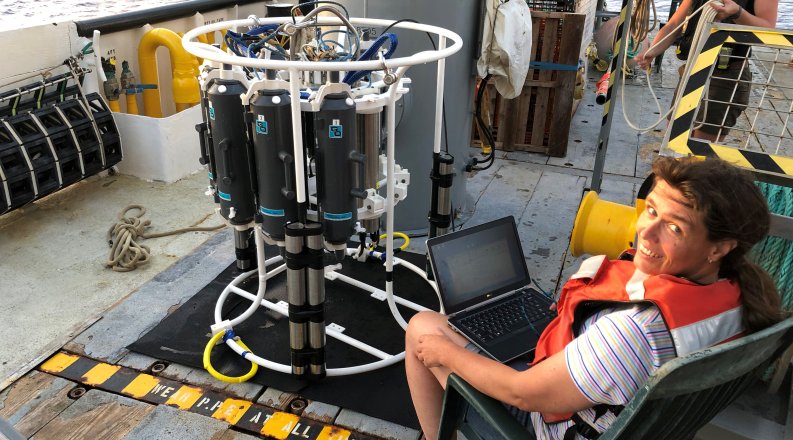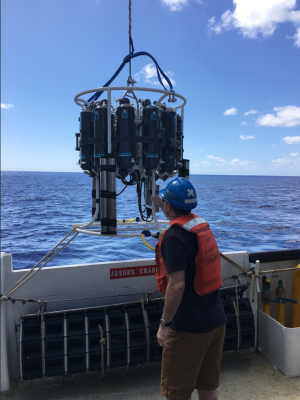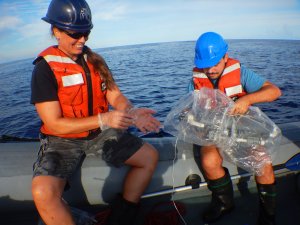By Victoria Bourne
Iron is all around us. It was critical for the biological processes that created a habitable Earth, and it fills every oxygen-transporting red blood cell in our bodies.
As essential on land as it is in the water, iron is a vital marine nutrient for tiny organisms called phytoplankton, which – through photosynthesis – are the foundation of the marine ecosystem and provide a key link between the ocean and atmosphere.
New research conducted by an international team of scientists, including two from Old Dominion University, highlights the importance of mineral forms of iron in regulating how this essential micronutrient cycles throughout the ocean and provides a new model to more accurately describe its distribution on a global scale.
"This study advances our understanding of the processes that control the availability of iron to marine phytoplankton, and how the levels of dissolved iron in the ocean vary in space and time," said Peter Sedwick, a professor in ODU's Department of Ocean & Earth Sciences and principal investigator for the U.S. component of the research effort. "Importantly, our research also improves our ability to understand how future environmental changes, such as a warming climate, may impact oceanic ecosystems.”
The study, published in the preeminent scientific journal Nature in early August, was led by U.K. collaborator Alessandro Tagliabue and co-authored by Sedwick, ODU research specialist Bettina Sohst and 10 other researchers representing the U.S., U.K., Australia and France. The research was funded by the National Science Foundation (NSF) and the U.K.’s Natural Environment Research Council, for around $1.4 million. ODU received $281,000, according to Sedwick.
The study’s primary focus was to understand on a granular level how iron behaves in the ocean – how it gets in there, and what controls its behavior in the oceanic water column over time, Sedwick said. The goal then was to use a numerical model of the ocean system to simulate iron distribution at both regional and global scales.
Major sources of iron in the ocean include river waters, melting glaciers, icebergs and sea ice, and hydrothermal activity – hot springs in volcanically active parts of the deep sea that spew iron, Sedwick said.
In remote areas of the open ocean, a significant source of iron is dust carried on the wind. "It's particularly important in the North Atlantic because North Africa is a major source of soil dust on the planet," Sedwick says.
Despite these varied distribution sources and being one of the most abundant elements on earth, iron is scarce in large areas of the open ocean, Sedwick said, which limits the growth of phytoplankton.
"In surface ocean waters where there's oxygen present, iron is very insoluble. And so even though there's inputs, it doesn't stick around for very long. It goes from the dissolved form to the particulate form and can be removed quite quickly into deeper ocean waters."
Phytoplankton – single-celled, photosynthetic microscopic organisms that live in the surface ocean – form the base of the marine food web and are consumed by a wide range of sea creatures. They also are a kind of canary in a coal mine when it comes to climate change. “They play a substantial role in setting the balance of carbon dioxide between the atmosphere and the deep ocean and sediments, because they fix dissolved carbon dioxide into organic matter using solar energy, which is continually transported into the deep ocean,” when the organisms die or are eaten, in a form of carbon sequestration, Sedwick said.
It's understood that iron inputs into the ocean were higher during the ice ages due to a drier, dustier climate, Sedwick said. That contributed to lower atmospheric carbon dioxide, less natural greenhouse effect and a colder climate. "As the climate warms, it's not quite certain how the inputs of iron into the ocean are going to change. And there's other things changing as well, ocean circulation, oxygen content – all these things changing in tandem,” Sedwick said. “It's important to understand how changing iron inputs and behavior in the ocean may impact the ocean ecosystem and atmospheric carbon dioxide going forward. Those changes might make climate warming worse, or they may act to lessen the impact of climate warming."
Fieldwork was conducted in 2019 in a well-studied part of the North Atlantic called the Bermuda Atlantic Time-series Study (BATS) region, located 47 miles southeast of Bermuda in the Sargasso Sea. Sampling occurred over roughly five-day increments in March, May, August and November to capture the seasonal variability of dissolved iron in the upper ocean.
“BATS is an excellent study location because of the well-understood seasonal succession of physical mixing and biological production, which peak in early spring,” Sedwick said. Iron input is greatest in the summertime, roughly June to August, due to soil dust transported on the wind from North Africa across the Atlantic.
"So, there's a very strong seasonal signal in iron,” he said. They used that to follow the different chemical forms of iron in the upper ocean to see how they varied in relation to each other. It was an important test of the conceptual and numerical models they were using, Sedwick said.
Samples were collected by “Mr. Mini,” a smaller, specialized version of a CTD-rosette sampling system widely used in oceanography to measure the physics and physical characteristics of water. Lowered from the ship by a cable, the devices record information like temperature, salinity and pressure in real time. Open bottles attached to a carrousel frame are closed at precise depths, capturing samples for further analysis and providing a snapshot of the entire water column at that moment and location.
“Mr. Mini” is specially designed to collect samples for iron, which is so ubiquitous it poses a contamination challenge. “On a ship there's lots of iron everywhere,” Sedwick said. “It's in dust, it's in your hair, it's in the rusty stuff on the ship. … It's even on conventional sampling devices.”
Sedwick’s device is made from powder-coated aluminum. Samples were collected from 12 depths in 5-liter plastic bottles, then processed in an onboard “clean lab van” made from a modified 20-foot container. Chemical analyses were completed later at ODU by Sohst, Sedwick’s lab manager.
Dissolved iron is not only present in an organic form that is bound by compounds produced by microbes, but also as colloids, which are tiny nanoparticles that essentially behave as if dissolved in solution. Importantly, what the researchers discovered is that the colloidal dissolved iron can aggregate together to form mineral particles, independent of the organically bound dissolved iron, via a process that the researchers have termed the “colloidal shunt.”
Sedwick said one implication of their research is that iron particles formed by the colloidal shunt carry some carbon as it eventually sinks from the ocean surface to deeper waters, augmenting the sequestration of carbon that is directly associated with phytoplankton production.
“Moreover, the organic carbon that is incorporated into particles via the colloidal shunt may be better protected from degradation in the deep ocean and in seafloor sediments, relative to other sinking organic matter,” Sedwick said.
Sedwick and Sohst are preparing for a 65-day research trip to Antarctica, which they will embark on in November. The expedition, led by Sedwick and colleagues Phoebe Lam (University of California Santa Cruz) and Robert Sherrell (Rutgers University), is part of the U.S. GEOTRACES program, which aims to improve the understanding of biogeochemical cycles and large-scale distribution of trace elements and their isotopes in the marine environment. Sedwick said the expedition will include work conducted as part of 23 NSF-funded projects that address a range of scientific questions.





